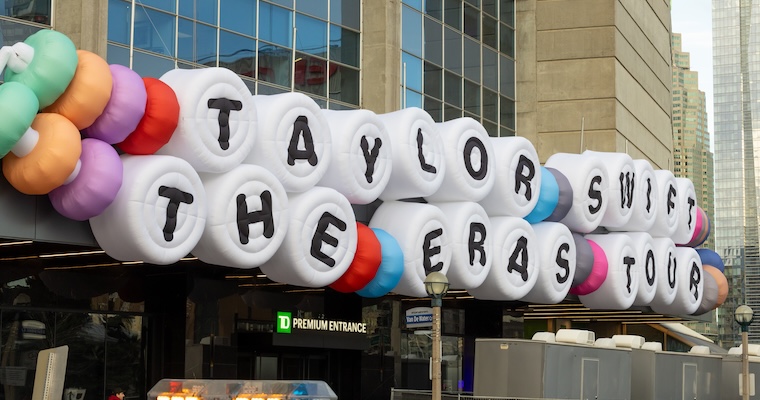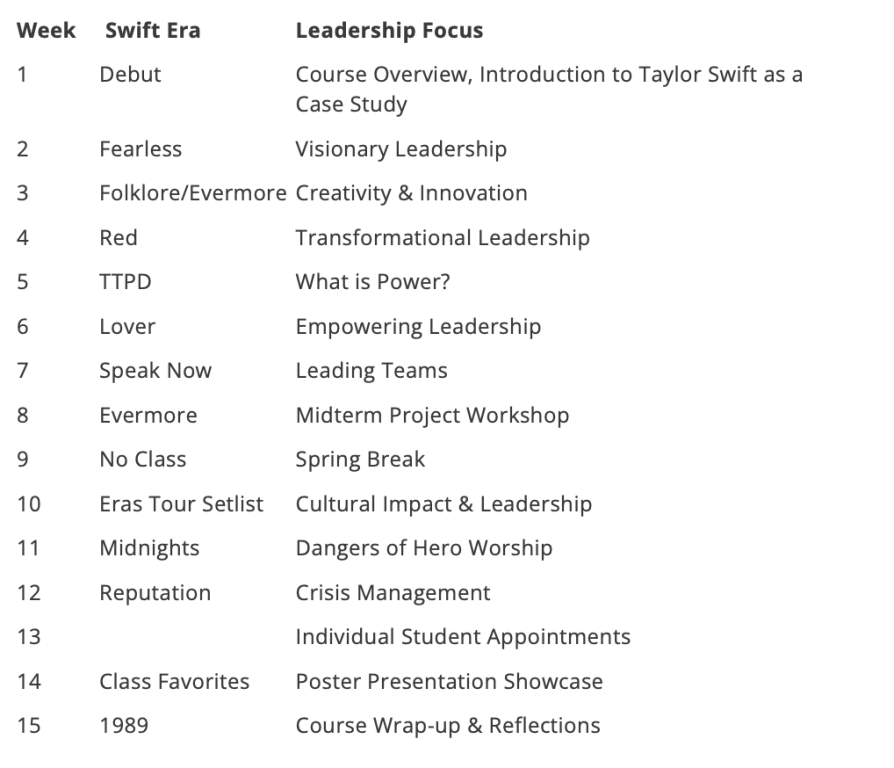Teaching Entrepreneurial Leadership Through the Lens of Taylor Swift

Pop culture is pedagogically potent in this engaging semester-long honors course, which has received rave reviews from students.
Entrepreneurial education often draws from case studies of business moguls or high-growth startups. However, few figures today offer as dynamic a model of entrepreneurial thinking, creative risk-taking, and visionary leadership as global pop icon Taylor Swift. Pop culture themes have become a widespread trend in higher education to attract student interest and foster motivation and engagement (Picault, 2019). Pop culture examples and case studies stand out due to their accessibility, ability to spread widely, entertainment value, and short-lived nature, which make them especially impactful and popular among younger learners (Singh, 2022).
In a semester-long, interdisciplinary honors colloquium course at Western Kentucky University, students explored the intersection of collaborative learning, creative project development, and entrepreneurial leadership by analyzing Swift’s career through the lens of organizational behavior, strategic influence, and creative innovation.
This article shares how that course was designed, implemented, and received, offering a replicable framework for educators seeking to teach entrepreneurial leadership in unconventional ways.
Course Context and Rationale
The course, Fearless Leadership: Unleashing Creativity and Innovation Through Taylor Swift's Influence, was taught as part of the university’s interdisciplinary Honors Colloquium series, which encourages faculty to experiment with cross-disciplinary topics. The goal is to allow students to participate in and lead discussions on various aspects of issues of contemporary, historical, or intellectual significance.
The course was designed to cater to an interdisciplinary student audience with the following learning objectives:
1. Understand core leadership theories and their practical applications.
2. Engage with interdisciplinary methods to explore creativity and innovation.
3. Create original projects showcasing leadership and creative strategies.
4. Develop skills in critical reflection, discussion, and peer feedback.
5. Explore the role of ethics, authenticity, and influence in leadership.
Taylor Swift’s entrepreneurial journey—from her battle for creative ownership to her reinvention across musical eras—offered fertile ground for demonstrating these objectives to students.
Given the interdisciplinary nature of the course, it was taught with an emphasis on entrepreneurial leadership, rather than a narrow focus on entrepreneurship. Entrepreneurial leadership is a style of leadership that crafts visionary scenarios to bring together and inspire a team of participants who, driven by the vision, become dedicated to discovering and pursuing opportunities for strategic value creation (Gupta, MacMillan, & Surie, 2004). In the case of Taylor Swift, she brings together fans in a way we have rarely (if ever) seen other artists accomplish in achieving her own goals, as well as her fans’.
In addition to entrepreneurial leadership, students were indirectly introduced to engaging in the entrepreneurial mindset. The entrepreneurial mindset stretches beyond the dominant realm of new venture creation to account for student interests, intentions, and capacities to engage in innovation and change leadership, regardless of organizational setting or intended results (Karatas-Ozkan et al., 2023). Organizational contexts and desired outcomes can vary widely, from generating profit, to promoting social change, to mobilizing communities, as well as improving the environment (Mars, Bogden, & Torres, 2024). Given the interdisciplinary nature of the course and the wide variety of majors of the students, students needed to learn through hands-on experience that an entrepreneurial mindset was not limited to those who resided in the business college.
Designing the Curriculum: A Leadership Journey in Eras
Each week of the course aligned with a different “Era” in Swift’s career and connected to a leadership or entrepreneurial theme. The themes also aligned with the course text, Swift Leadership: A Taylor-made Approach to Influence and Decision Making (Yates & Urick, 2025). Here is a sample structure:

The readings were paired with media analyses, documentaries, and Swift’s own content, from lyrics to social media. By requiring students to engage with multiple forms of media, they were pushed to question assumptions, recognize potential biases, and evaluate the validity of information presented to them. Utilizing these foundational critical thinking skills and emphasizing the importance of media literacy aids in fostering an analytical mindset (Andersson, 2021), which is essential for students of all disciplines.
Signature Assignments and Experiential Learning
The course emphasized experiential learning through activities like:
Vision Boarding
Students created leadership vision boards to reflect their creative project aspirations. These boards were created physically in class using magazines provided by the instructor. Physical vision boards were chosen over digital versions to offer students a more tactile experience that was free from digital distractions.
Vision boards are typically made up of words, pictures, and symbols that serve as a visual representation of one's aspirations or goals (Dixon, Hornsey, & Hartley, 2023). Studies have shown that visualization can strengthen feelings of success around goal attainment by activating neural pathways linked to motivation and self-efficacy (Subramanian, 2006). Given that students were being asked to plan ambitious and creative projects that were likely out of their comfort zone, it was deemed especially important to foster feelings of motivation and self-efficacy.
Discussion Leaders
Assigned students would be responsible for coordinating and facilitating the class discussions over the weekly readings, fostering a hands-on approach to engagement with the course content.
Reading summaries and class discussions were structured and directed by student leaders each week, which drove high levels of engagement and rich dialogue. Student-led discussions have been found to foster greater student-to-student interactions, increase active learning, and lead to better course performance compared to instructor-led discussions (e.g., Brank & Wylie, 2013; Voelkl, 1995).
To ensure students were well-prepared as class facilitators, guides were provided for composing their summaries and discussion prompts. The guides emphasized the main components that should be covered, while also allowing students freedom to conduct the discussion as they saw fit.
Discussion leaders were expected to provide an overview of the key concepts covered in the readings, draw connections between concepts and their observations of Taylor Swift, provide personal insights, and bring in additional resources (YouTube videos, academic studies, other pop culture references, etc.) to further elaborate on the lessons of the week.
Discussion leaders worked in pairs each week to lead the discussions with their prepared prompts. Students were instructed to ask questions that would:
- Encourage critical thinking and reflection.
- Relate to the assigned material and its application to real-world scenarios.
- Allow peers to share their perspectives and experiences.
In terms of evaluation, discussion leaders were graded on the following criteria:
- Quality of Summary: Clear understanding of material, depth of analysis, and connection to
- course themes.
- Discussion Questions: Relevance, creativity, and ability to prompt meaningful discussion.
- Facilitation Skills: Engagement with peers, clarity of communication, and ability to foster inclusive dialogue.
Leadership & Creativity Journals
Students drafted hand-written reflections each week, connecting the readings and theories to their personal development.
Students were given time in class to write their reflections, subsequently following the weekly discussions. In keeping with our Taylor Swift theme, each week had a "soundtrack," and the album of the week would be played in the background for the remainder of the class period.
Listening to music has been shown to stimulate the default mode network (DMN) of the brain, which is associated with self-referential thinking, mind-wandering, empathy, and imagination (Zaatar, Alhakim, Enayeh, & Tamer, 2023), all of which help to foster a creative learning environment.
Creative Leadership Project
Students applied Swift’s innovative and entrepreneurial strategies to their own interests. Students ideated, prototyped, and refined their business or creative concepts while receiving instructor mentorship and peer feedback throughout the course. Project examples by discipline include:
- Business/Marketing: Developing a social media campaign or product launch inspired by Swift’s branding strategies.
- Technology & Digital Engagement: Designing an app or platform to enhance audience interaction, mirroring Swift’s innovative use of digital content.
- Education & Social Entrepreneurship: Creating educational curriculum or community-based initiatives informed by Swift’s philanthropic approach.
- Arts & Music: Producing original creative works inspired by Swift’s lyrics.
- STEM: Conducting large-scale science experiments to better understand the impact of stage effects in concerts such as the Eras Tour.
Teaching the Class
The course was taught in a 3-hour format once a week over a 15-week semester. This format lent to a workshopping approach, allowing students to spend a significant amount of class time each week working on their Creative Leadership Project. After the weekly discussion and reflection times, the remainder of the class would be spent focusing on the students' creative leadership projects.
To wrap up each class period, students would report to the rest of the class the progress they had made that week, as well as their goals for the upcoming week. Students would provide one another feedback and suggestions, which ranged from potential contacts that their classmates could reach out to for assistance, to proposing software or apps that could be helpful in meeting stated goals. This allotted class time helped to facilitate peer interaction (or peer learning), a collaborative form of learning where students acquire knowledge and skills through actively assisting and supporting their peers (Topping, 2005). These forms of cooperative learning and peer interaction have been shown to improve academic achievement, psychological well-being, and the development of social skills (Johnson & Johnson, 2009).
The Creative Leadership Projects concluded with a student showcase, where students presented their project results through poster displays, attended by guests from across the university who listened to the presentations and engaged in one-on-one conversations with the students.
Student Impact and Feedback
Student reflections revealed meaningful growth in both confidence and personal leadership capabilities. One student wrote, “I never thought of myself as a leader, but seeing how Taylor Swift uses her platform to drive change made me realize I can lead in my own way.”
Others reported gaining:
- A deeper understanding of the ethical dilemmas leaders face.
- Appreciation for lessons and knowledge acquired through failure.
- Recognition of the significance of a clear and actionable vision.
Anonymous course evaluations praised the innovative format, stating “…this class has challenged me, made me a more capable leader, and given me a chance to interact with my community in ways I never would have otherwise” and “I learned a lot about how leadership applies to Taylor Swift, the different factors that make a leader, and how I can apply these lessons to my own life.”
Key Takeaways for Educators
This approach offers several insights for entrepreneurship educators:
Pop culture is pedagogically potent. Meeting students where they are in terms of their cultural interests can increase engagement and retention of complex theories. Cultural synchronization and shared understanding are advanced when students' knowledge and pop culture interests are integrated into the classroom (Sfeir, 2014).
Entrepreneurship is everywhere. From music tours to social activism, students begin to see entrepreneurship as a mindset, not just a business function. By recognizing entrepreneurship through the mindset lens, students are better able to recognize opportunities, utilize critical thinking, and engage in problem-solving (Dinh, Oberrauch, & Dewalt, 2022).
Creative assignments deepen learning. By embracing nontraditional formats, students exercise higher-order thinking and emotional intelligence, skills that are highly needed for the future success of entrepreneurially minded students (Vapiro & St-Onge, 2025).
Replicating or Adapting the Course
Interested faculty could adapt this model to focus on other artists, influencers, or entrepreneurs who exhibit leadership behaviors in public life. For example, Beyoncé for strategic partnership, MrBeast for viral marketing and philanthropy, or Greta Thunberg for activism-based leadership.
Beyond leadership, other entrepreneurial themes are ripe for exploration through the lens of pop culture. Examples could include Dolly Parton for community-based entrepreneurship, Michael Jordan for licensing and long-term brand legacy, or Dwayne “The Rock” Johnson for diversifying revenue streams.
Educators are encouraged to:
- Choose a public figure relevant to their students.
- Align weekly themes with established academic theories.
- Design creative assessments that challenge students to apply knowledge in novel ways.
Conclusion: Let the Pop Lead
Taylor Swift’s career is more than a discography…It's a masterclass in brand evolution, stakeholder engagement, and leadership identity. By drawing from her story and stories of other pop culture icons, we can reimagine how we teach entrepreneurship and develop a new generation of creative, reflective, and ethical leaders.
References
Andersson, L. (2021). It's Critical: The Role of Critical Thinking in Media and Information Literacy. Halmstad University, School of Health and Welfare, Halmstad, Sweden ORCID: https://orcid.org/0000-0002-4697-5394
Brank, E., & Wylie, L. (2013). Let's discuss: Teaching students about discussions. Journal of the Scholarship of Teaching and Learning, 13(3), 15–28.
Dinh, A., Oberrauch, L., & Dewalt, S. (2022). What's in a mindset? Exploring the entrepreneurial mindset. Journal of Entrepreneurship Education, 25(4), 1-24.
Dixon, L. J., Hornsey, M. J., & Hartley, N. (2023). "The secret" to success? The psychology of belief in manifestation. Personality and Social Psychology Bulletin, 51 (1) 49-65. https://doi.org/10.1177/01461672231181162
Gupta, V., I. C. MacMillan, & G. Surie (2004). "Entrepreneurial leadership: Developing and measuring a cross-cultural construct, "Journal of Business Venturing 19(2), 241–260.
Heljakka, K. (2023). Building playful resilience in higher education: Learning by doing and doing by playing. In Frontiers in Education (Vol. 8, p. 1071552). Frontiers Media SA.
Johnson, D. W., & Johnson, R. T. (2009). An Educational Psychology Success Story: Social Interdependence Theory and Cooperative Learning. Educational Researcher, 38(5), 365–379. https://doi.org/10.3102/0013189X09339057
Karatas-Ozkan, M., Ibrahim, S., Ozbilgin, M., Fayolle, A., Manville, G., Nicolopoulou, K., Tatli, A., & Tunalioglu, M. (2023). Challenging the assumptions of social entrepreneurship education and repositioning it for the future: wonders of cultural, social, symbolic and economic capitals. Social Enterprise Journal, 19(2), 98–122.
Mars, M. M., Bogden, A., & Torres, R. M. (2024). The influence of interdisciplinary entrepreneurial leadership learning on entrepreneurial mindset development. Entrepreneurship Education, 7(1), 67-85.
Picault, J. (2019). The economics instructor's toolbox. International Review of Economics Education, 30, 100154.
Sfeir, G. (2014). Critical pedagogy through popular culture. Education Matters: The Journal of Teaching and Learning, 2(2).
Singh, A. K. (2022). A study of popular culture and its impact on youth's cultural identity. The Creative Launcher, 7(6), 150–157.
Subramanian, P. S. (2006). Active vision: The psychology of looking and seeing. Journal of Neuro-Ophthalmology, 26(1), 69–70.
Topping, K. (2005). Trends in peer learning. Educational Psychology, 25, 631–645.
Varpio, L., & St-Onge, C. (2025). Defining, cultivating, and assessing entrepreneurial mindset in higher education: A review. European Journal of Engineering Education, 50(4), 1-16.
Voelkl, K. E. (1995). School warmth, student participation, and achievement. Journal of Experimental Education, 63, 127–138. doi: 10.1080/00220973.1995.9943817
Yates, M., & Urick, M. J. (2025). Swift leadership: A Taylor-made approach to influence and decision making (Exploring Effective Leadership Practices through Popular Culture). Emerald Publishing. https://doi.org/10.1108/978-1-83549-620-620251012
Zaatar, M.T., Alhakim, K., Enayeh, M., & Tamer, R. (2023). The transformative power of music: Insights into neuroplasticity, health, and disease. Brain, behavior, & immunity - health, 35, 100716. https://doi.org/10.1016/j.bbih.2023.100716

Associate Professor / Management Department / Western Kentucky University
View Profile





